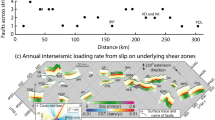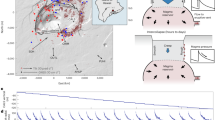Abstract
It is thought that small ‘static’ stress changes due to permanent fault displacement can alter the likelihood of, or trigger, earthquakes on nearby faults1. Many studies of triggering in the near-field, particularly of aftershocks, rely on these static changes as the triggering agent2,3,4 and consider them only in terms of equivalent changes in the applied load on the fault3,4,5,6. Here we report a comparison of the aftershock pattern of the moment magnitude Mw = 7.3 Landers earthquake, not only with static stress changes but also with transient, oscillatory stress changes transmitted as seismic waves (that is, ‘dynamic’ stresses). Dynamic stresses do not permanently change the applied load and thus can trigger earthquakes only by altering the mechanical state or properties of the fault zone. These dynamically weakened faults may fail after the seismic waves have passed by, and might even cause earthquakes that would not otherwise have occurred. We find similar asymmetries in the aftershock and dynamic stress patterns, the latter being due to rupture propagation, whereas the static stress changes lack this asymmetry. Previous studies have shown that dynamic stresses can promote failure at remote distances7,8,9,10,11,12, but here we show that they can also do so nearby.




Similar content being viewed by others
References
Harris, R. A. Introduction to special section: Stress triggers, stress shadows, and implications for seismic hazard. J. Geophys. Res. 103, 24347–24358 (1998).
Dieterich, J. A. A constitutive law for rate of earthquake production and its application to earthquake clustering. J. Geophys. Res. 99, 2601–2618 (1994).
Toda, S., Stein, R. S., Reasenberg, P. A., Dieterich, J. & Yoshida, A. Stress transferred by the 1995 Mw=6.9 Kobe, Japan shock: Effect on aftershocks and future earthquake probabilities. J. Geophys. Res. 103, 24543–24566 (1998).
King, G. C. P., Stein, R. S. & Lin, J. Static stress changes and the triggering of earthquakes. Bull. Seismol. Soc. Am. 84, 935–953 (1994).
Jaume, S. C. & Sykes, L. R. Changes in state of stress on the southern San Andreas Fault resulting from the California earthquake sequence of April to June, 1992. Science 258, 1325–1328 (1992).
Harris, R. A. & Simpson, R. W. Changes in static stress on southern California faults after the 1992 Landers earthquake. Nature 360, 251–254 (1992).
Anderson, J. G. et al. Seismicity in the western Great Basin apparently triggered by the Landers, California, earthquake, 28 June 1992. Bull. Seismol. Soc. Am. 84, 863–891 (1994).
Gomberg, J. & Bodin, P. Triggering of the Little Skull Mountain, Nevada earthquake with dynamic strains. Bull. Seismol. Soc. Am. 84, 844–853 (1994).
Gomberg, J. Stress/strain changes and triggered seismicity following the Ms7.3 Landers, California, earthquake. J. Geophys. Res. 101, 751–764 (1996).
Gomberg, J. & Davis, S. Stress/strain changes and triggered seismicity at The Geysers, California. J. Geophys. Res. 101, 733–749 (1996).
Hill, D. P. et al. Seismicity remotely triggered by the magnitude 7.3 Landers, California, earthquake. Science 260, 1617–1623 (1993).
Hill, D. P., Johnston, M. J. S., Langbein, J. O. & Bilham, R. Response of Long Valley caldera to the Mw=7.3 Landers, California, earthquake. J. Geophys. Res. 100, 12985–13005 (1995).
Gomberg, J., Beeler, N. M., Blanpied, M. L. & Bodin, P. Earthquake triggering by transient and static deformations. J. Geophys. Res. 103, 24411–24426 (1998).
Boatwright, J. & Cocco, M. Frictional constraints on crustal faulting. J. Geophys. Res. 101, 13895–13909 (1996).
Gomberg, J., Blanpied, M. L. & Beeler, N. M. Transient triggering of near and distant earthquakes. Bull. Seismol. Soc. Am. 87, 294–309 (1997).
Atkinson, B. K. Subcritical crack growth in geologic materials. J. Geophys. Res. 89, 4077–4114 (1984).
Richardson, E. & Marone, C. Effects of normal stress vibrations on frictional healing. J. Geophys. Res. 104, 28857–28878 (1999).
Dreger, D. S. Investigation of the rupture process of the 28 June 1992 Landers earthquake utilizing TERRAscope. Bull. Seismol. Soc. Am. 84, 713–724 (1994).
Wald, D. J. & Heaton, T. H. Spatial and temporal distribution of slip for the 1992 Landers, California, earthquake. Bull. Seismol. Soc. Am. 84, 668–691 (1994).
Hauksson, E., Jones, L. M., Hutton, K. & Eberhart-Phillips, D. The 1992 Landers earthquake sequence: seismological observations. J. Geophys. Res. 98, 19835–19858 (1993).
Matthews, M. V. & Reasenberg, P. A. Statistical methods for investigating quiescence and other temporal seismicity patterns. Pure Appl. Geophys. 126, 357–372 (1988).
Reasenberg, P. A. & Simpson, R. W. Response of regional seismicity to the static stress change produced by the Loma Prieta earthquake. Science 255, 1687–1690 (1992).
Cotton, F. & Coutant, O. Dynamic stress variations due to shear faults in a plane-layered medium. Geophys. J. Int. 128, 676–688 (1997).
Frohlich, C. & Davis, S. D. Single-link cluster analysis as a method to evaluate spatial and temporal properties of earthquake catalogs. Geophys. J. Int. 100, 19–32 (1990).
Davis, S. D. & Frohlich, C. Single-link cluster analysis of earthquake aftershocks: decay laws and regional variations. J. Geophys. Res. 96, 6335–6350 (1991).
Acknowledgements
We are grateful to F. Cotton, O. Coutant, P. Reasenberg and S. Davis for kindly supplying us with their computer codes. We thank S. Hough, M. Johnston & C. Marone for thoughtful reviews. The US Geological Survey funded this work.
Author information
Authors and Affiliations
Corresponding author
Rights and permissions
About this article
Cite this article
Kilb, D., Gomberg, J. & Bodin, P. Triggering of earthquake aftershocks by dynamic stresses. Nature 408, 570–574 (2000). https://doi.org/10.1038/35046046
Received:
Accepted:
Issue Date:
DOI: https://doi.org/10.1038/35046046
- Springer Nature Limited
This article is cited by
-
The 2022 Goesan earthquake of the moment magnitude 3.8 along the buried fault in the central Korean Peninsula
Journal of Seismology (2024)
-
Intermittent lab earthquakes in dynamically weakening fault gouge
Nature (2022)
-
Modeling and Prediction of Aftershock Activity
Surveys in Geophysics (2022)
-
Real-time determination of earthquake focal mechanism via deep learning
Nature Communications (2021)
-
Stress relaxation arrested the mainshock rupture of the 2016 Central Tottori earthquake
Communications Earth & Environment (2021)





